List of largest craters in the Solar System
Following are the largest impact craters on various worlds of the Solar System. For a full list of named craters, see List of craters in the Solar System.
| Body | Crater | Crater diameter | Body diameter | Ratio | Images | Notes |
|---|---|---|---|---|---|---|
| Mercury | Caloris | 1,550 km (963 mi) | 4880 km | 32% | 
|
|
| Rembrandt | 715 km (444 mi) | 15% | 
|
|||
| Venus | Mead | 280 km (170 mi) | 12100 km | 2% |  |
|
| Earth | Vredefort | 250–300 km (160–190 mi) | 12740 km | 2% | 
|
|
| Sudbury Basin | 250 km (160 mi) | 2% | 
|
|||
| Chicxulub crater | 182 km (113 mi) | 1.4% | 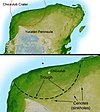
|
Cause of the Cretaceous–Paleogene extinction event | ||
| Luna (moon of Earth) |
Procellarum | 3,000 km (2,000 mi) | 3470 km | 86% | 
|
Not confirmed as an impact basin. |
| South Pole–Aitken basin | 2,500 km (1,600 mi) | 70% | 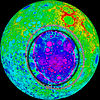
|
|||
| Imbrium | 1,145 km (711 mi) | 33% | 
|
|||
| Mars | North Polar Basin | 10,600 × 8,500 km (6,550 × 5,250 mi) | 6780 km | 125–155% | 
|
Not confirmed as an impact basin |
| Utopia | 3,300 km (2,100 mi) | 50% | 
|
Largest confirmed impact basin on Mars and in the Solar System | ||
| Hellas | 2,300 km (1,400 mi) | 34% | 
|
Largest visible crater in the Solar System | ||
| Vesta (asteroid) | Rheasilvia | 505 km (310 mi) | 529 km (569 km)[1] | 90%[1] | 
|
|
| Veneneia | 395 km (250 mi) | 70%[1] | 
|
Partially obscured by Rheasilvia | ||
| Ceres (asteroid) | Kerwan | 284 km (180 mi)[2] | 952 km | 30% | 
|
Faint shallow crater, below the center of this image. |
| Yalode | 271 km (170 mi)[2] | 28% | 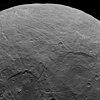
|
|||
| Hygiea (asteroid) | Serpens | 180±15 | 434 ± 14 km | 40% | ||
| Ganymede (moon of Jupiter) |
Epigeus | 343 km (213 mi) | 5270 km | 6.5% | 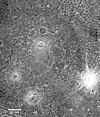
|
|
| Callisto (moon of Jupiter) |
Valhalla | 360 km (224 mi) | 4820 km | 7.5% | 
|
|
| Heimdall | 210 km (130 mi) | 4% | (no good images have been taken) | |||
| Mimas (moon of Saturn) |
Herschel | 139 km (86 mi) | 396 km | 35% | 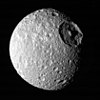
|
|
| Tethys (moon of Saturn) |
Odysseus | 445 km (277 mi) | 1060 km | 42% | 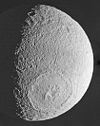
|
|
| Dione (moon of Saturn) |
Evander | 350 km (220 mi)[3] | 1123 km | 34% | 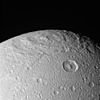
|
|
| Rhea (moon of Saturn) |
Mamaldi | 480 km (300 mi)[4] | 1530 km | 31% | 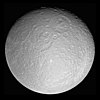
|
|
| Tirawa | 360 km (220 mi) | 24% | 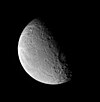
|
|||
| Titan (moon of Saturn) |
Menrva | 392 km (244 mi) | 5150 km | 7.5% | 
|
|
| Iapetus (moon of Saturn) |
Turgis | 580 km (360 mi) | 1470 km | 40% | 
|
|
| Engelier | 504 km (313 mi) | 34% | 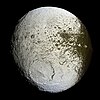
|
|||
| Gerin | 445 km (277 mi) | 30% | 
|
Gerin is overlain by Engelier | ||
| Falsaron | 424 km (263 mi) | 29% | 
|
|||
| Titania (moon of Uranus) |
Gertrude | 326 km (203 mi) | 1580 km | 21% | 
|
Little of Titania has been imaged, so it may well have larger craters. |
| Pluto | Sputnik basin | ca. 1,300 × 900 km | 2370 km | 34–44% | 
|
|
| unnamed crater | 450 km (280 mi) | 19% | 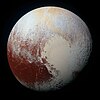
|
Upper right of image, difficult to see | ||
| Charon (moon of Pluto) |
Mordor Macula | ca. 475 km (295 mi) | 1207 km | 40% | 
|
Dark region at north pole. Not confirmed as an impact basin. |
| Dorothy | ca. 261 km (162 mi) | 21% | 
|
Crater at upper right overlapping Mordor Macula |
See also[]
- List of largest lakes and seas in the Solar System
- List of largest rifts and valleys in the Solar System
- List of tallest mountains in the Solar System
References[]
Categories:
- Lists of impact craters
- Solar System
- Lists of superlatives in astronomy
- Solar System-related lists